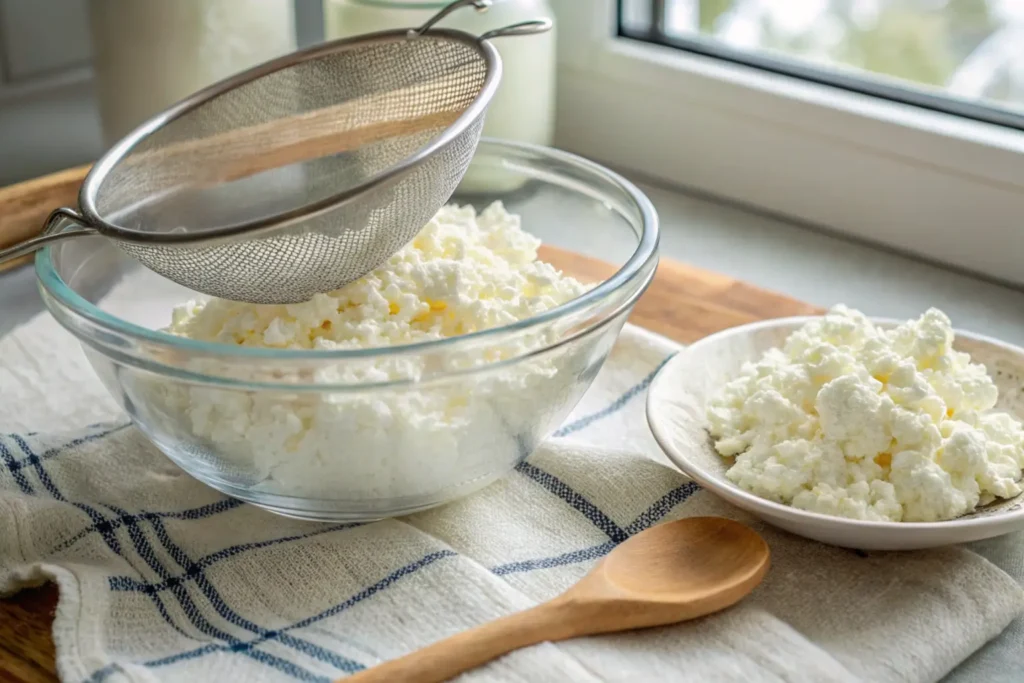Introduction
Can cottage cheese be substituted for ricotta on pizza? It’s a question many home cooks ask when they’re out of ricotta but still craving a homemade pizza. Cottage cheese is a kitchen staple for a lot of people, but is it a good fit for pizza? To decide, we need to explore the differences between these two cheeses—focusing on texture, flavor, and nutrition. By the end of this section, you’ll have a clearer idea of whether cottage cheese is the swap you’re looking for.
Understanding the Key Differences Between Cottage Cheese and Ricotta
Texture Comparison: Cottage Cheese vs. Ricotta
The first difference to consider is texture. Ricotta is smooth, creamy, and easy to spread, which makes it ideal for pizza recipes. Cottage cheese, however, has a chunkier texture with distinct curds and more moisture. This means it might not spread as easily or create the same silky base for your pizza toppings unless you prep it. Don’t worry, though—there are ways to adjust cottage cheese to make it work, which we’ll cover later.
Flavor Profiles: What Sets Them Apart?
When it comes to flavor, ricotta and cottage cheese have their own personalities. Ricotta has a mild, slightly sweet taste that complements a variety of toppings, from savory meats to fresh veggies. Cottage cheese, on the other hand, has a tangier and saltier flavor. This makes it a bold choice that can bring an unexpected zest to your pizza. However, it’s not a perfect flavor match, so if you’re aiming for a classic ricotta experience, you’ll need to tweak it a bit.
Curious about other cheese options? Dive into What Is the Best Cheese for Pizza Crust? for a broader perspective.
Nutritional Variations Between Cottage Cheese and Ricotta
Nutritionally, cottage cheese has some clear advantages. It’s typically lower in calories and fat than ricotta, making it a healthier choice for those watching their diet. It’s also higher in protein, which can be a big plus if you’re looking to make your pizza a little more filling. Ricotta, while richer and creamier, has a higher fat content, which can add indulgence to recipes but might not align with health-conscious goals.
Is Cottage Cheese a Good Substitute?
So, can cottage cheese be substituted for ricotta on pizza? The answer depends on what you’re looking for. Cottage cheese can work beautifully if you’re willing to adjust the texture and enhance the flavor to better mimic ricotta. It’s a lighter, protein-packed option that’s both budget-friendly and versatile. However, if you’re after ricotta’s creamy and mildly sweet flavor straight from the container, cottage cheese might not be an exact match.
For more insights, check out Can Cottage Cheese Be Used on Pizza? to explore additional tips and tricks.
Why Consider Substituting Cottage Cheese for Ricotta?
Healthier Pizza Topping Option
When thinking, “Can cottage cheese be substituted for ricotta on pizza?” the health benefits are one of the first things that come to mind. Cottage cheese is a lower-calorie, higher-protein option compared to ricotta, making it ideal for those aiming to eat lighter without sacrificing the creamy texture they love on pizza. With less fat and fewer calories per serving, cottage cheese can help you create a pizza that’s satisfying and guilt-free.
If you’re topping your pizza with fresh vegetables like spinach, mushrooms, or zucchini, using cottage cheese as a base adds extra protein without weighing things down. It’s a win-win for flavor and nutrition, especially if you’re trying to make smarter food choices while enjoying your favorite comfort food.
A Cost-Effective Alternative
Let’s face it—ricotta cheese can be pricey, especially if you need a lot for a big pizza or multiple pies. If you’ve ever asked, “Can cottage cheese be substituted for ricotta on pizza to save money?” the answer is absolutely yes! Cottage cheese is often less expensive, widely available, and sold in larger containers, giving you more bang for your buck.
This budget-friendly swap means you can stretch your ingredients further without compromising on flavor. Plus, any leftover cottage cheese can easily be repurposed into other meals, such as protein-packed breakfast bowls, smoothies, or savory dips. For families or anyone hosting a pizza night, this is a practical and economical choice that still delivers on taste.
Versatility for Creative Recipes
Another reason to consider cottage cheese when asking, “Can cottage cheese be substituted for ricotta on pizza?” is its versatility. Cottage cheese can easily adapt to different pizza styles, from classic margherita to more adventurous combinations like BBQ chicken or veggie-loaded pies. Its slightly tangy flavor brings a unique twist to traditional recipes, adding a fresh dimension to your pizza.
Whether you’re making a creamy white pizza or experimenting with bold toppings, cottage cheese can fit right in. A few tweaks—like blending it for a smoother texture or enhancing its flavor with herbs and spices—can help it shine as a ricotta alternative while offering its own unique qualities.
A Health-Conscious Choice for Pizza Night
If you’re someone who loves pizza but wants to stay mindful of nutritional choices, cottage cheese is a game-changer. By swapping ricotta for cottage cheese, you can reduce the overall fat content of your pizza while adding a boost of protein. This makes it an excellent choice for fitness enthusiasts, busy parents, or anyone looking to maintain a balanced diet.
So, can cottage cheese be substituted for ricotta on pizza in a way that satisfies both your taste buds and health goals? Absolutely. With its nutritional perks, cost-effectiveness, and ability to adapt to various pizza recipes, it’s a cheese worth considering for your next pizza adventure.
Preparing Cottage Cheese as a Ricotta Substitute
Draining Excess Liquid for a Thicker Consistency

Here’s where things get a little technical—but don’t worry, it’s easy. Cottage cheese has a lot more liquid than ricotta, which means you’ll need to prep it a bit before using it as a substitute. If you skip this step, you might end up with a soggy pizza, and nobody wants that.
Start by placing the cottage cheese in a fine mesh strainer or lining a bowl with cheesecloth. Let it sit for about 10–15 minutes to allow the excess liquid to drain. If you’re in a hurry, you can gently press down on the curds with the back of a spoon to speed things up. Once it’s thicker, you’ll notice it starts to resemble the texture of ricotta a bit more.
This step is essential for achieving that creamy consistency you need for spreading or layering on your pizza. Skipping it might leave you with a watery mess, so trust me—it’s worth the extra few minutes.
Enhancing Flavor for a Closer Match to Ricotta
Even after draining, cottage cheese has a tangier and saltier flavor than ricotta. To get it closer to ricotta’s mild, creamy profile, you can make a few simple tweaks. Adding a splash of heavy cream or whole milk works wonders for richness. You can also stir in a drizzle of olive oil for that silky texture ricotta is known for.
For an added flavor boost, try mixing in grated parmesan or romano cheese. These hard cheeses add a nutty, savory kick that complements the tanginess of cottage cheese while mellowing it out a bit. Don’t forget to taste as you go—you want the mixture to be balanced but not overpowering.
Finally, seasoning is your best friend. A pinch of salt, a crack of black pepper, and a sprinkle of garlic powder can transform cottage cheese into something that feels much more “pizza-worthy.” If you’re a fan of herbs, a dash of dried oregano or basil can tie the flavors together perfectly.
Recipes and Techniques for Using Cottage Cheese on Pizza
Blending Cottage Cheese for a Creamier Texture
If you’re worried about the lumpiness of cottage cheese, don’t sweat it—a quick blend can fix that. Toss your cottage cheese into a food processor or blender and pulse it a few times until it’s smooth and creamy. This step is especially useful for white pizzas or recipes where the cheese acts as a base layer. Blending gives you that velvety texture that spreads easily and looks just like ricotta.
Blending also helps the cottage cheese integrate better with other ingredients. Whether you’re topping it with sautéed mushrooms, roasted garlic, or caramelized onions, having a smooth base makes everything feel more cohesive. Plus, it’s an easy trick to elevate your pizza’s overall look and taste.
Pairing Cottage Cheese with Other Pizza Ingredients

Cottage cheese is surprisingly versatile when it comes to pairing with other toppings. For a classic margherita vibe, layer it with fresh basil, sliced tomatoes, and a drizzle of olive oil. The tangy cheese provides a nice contrast to the sweet tomatoes and earthy basil.
You can also learn about Cottage Cheese Pizza Crust for a unique spin on your pizza-making.
Looking for something heartier? Try pairing cottage cheese with grilled veggies like zucchini, eggplant, or roasted bell peppers. The creaminess of the cheese balances out the smoky, slightly charred flavors of the veggies. Add a sprinkle of red pepper flakes if you like a little heat.
For meat lovers, cottage cheese works beautifully with cooked sausage, crispy bacon, or shredded chicken. The extra protein complements the cheese’s already high protein content, making for a pizza that’s both filling and flavorful. And if you’re into experimenting, consider adding some arugula or spinach on top right after baking—it adds a fresh, peppery bite that contrasts nicely with the creamy cheese.
Overall, the trick is to play around with flavors and textures. Cottage cheese is flexible enough to work with almost anything, so don’t be afraid to get creative. With a little planning, you can make it the star of your pizza or a supporting player in a symphony of delicious toppings.
Potential Drawbacks and Limitations of Substituting Cottage Cheese
Differences in Cooking and Melting Properties
One big thing to note is how cottage cheese behaves when cooked. Unlike ricotta, which stays creamy and smooth under heat, cottage cheese doesn’t melt in the same way. Its curds tend to separate, which might not be ideal if you’re after a cohesive, gooey texture on your pizza. While this isn’t a dealbreaker, it’s something to consider depending on your recipe.
Taste Adjustments to Suit Preferences
Cottage cheese has a slightly tangier taste compared to ricotta, which may not suit everyone’s palate. If you’re after a milder flavor, you might need to adjust the seasoning or combine it with other cheeses. Adding herbs like basil or oregano can also help balance the tanginess and create a flavor profile closer to traditional ricotta.
FAQs
Can you use cottage cheese in place of ricotta?
Yes, cottage cheese can be used in place of ricotta, especially in recipes where a creamy texture isn’t critical. It’s a great low-fat, high-protein alternative, but you may need to tweak its consistency and flavor to better mimic ricotta.
Can cottage cheese be used on pizza?
Absolutely! Cottage cheese can be a delicious addition to pizza, especially when combined with other ingredients. It works best when blended for a smoother texture or paired with bold toppings to balance its tangy flavor.
What do Italians use instead of ricotta in lasagna?
In Italy, béchamel sauce is often used as a substitute for ricotta in lasagna. This creamy, white sauce provides a rich and smooth layer that complements the other ingredients beautifully.
Does cottage cheese melt?
No, cottage cheese doesn’t melt like other cheeses such as mozzarella or ricotta. Its curds may soften slightly under heat, but they won’t create the same creamy, gooey effect.
Conclusion
So, can cottage cheese be substituted for ricotta on pizza? The answer is a resounding “it depends!” With a few tweaks and some creativity, cottage cheese can be a great stand-in that’s healthier, budget-friendly, and full of protein. However, understanding its limitations and adjusting your recipe accordingly is key. Whether you’re trying to save money, cut calories, or simply try something new, cottage cheese is worth experimenting with. And hey, pizza is always better when it’s personalized to your taste!


2 thoughts on “Can Cottage Cheese Be Substituted for Ricotta on Pizza? Learn How”